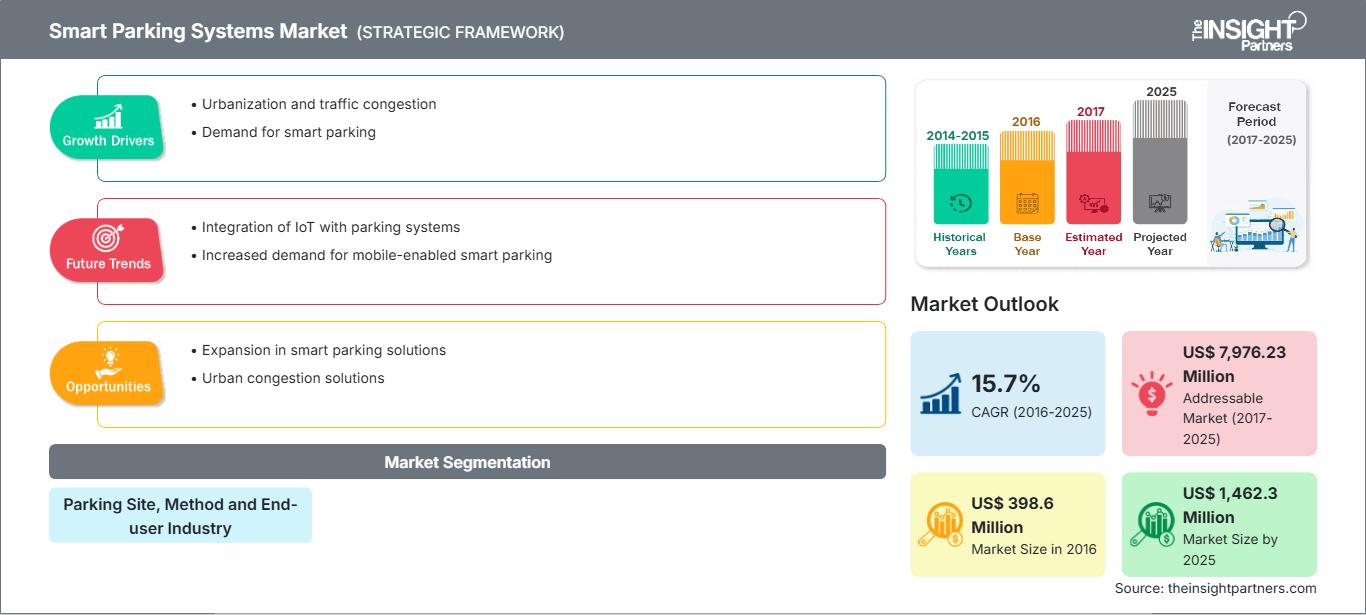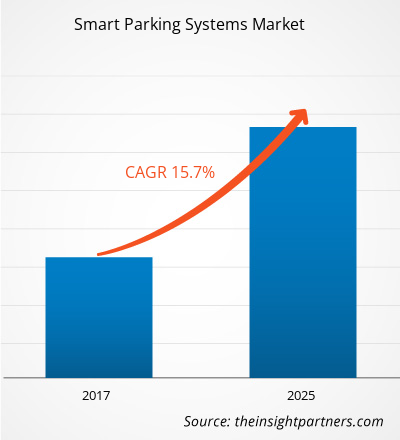Il mercato dei sistemi di parcheggio intelligenti è stato valutato a 398,6 milioni di dollari nel 2016 e si prevede che raggiungerà i 1.462,3 milioni di dollari entro il 2025; si prevede una crescita a un CAGR del 15,7% tra il 2017 e il 2025.
Il parcheggio è una questione complessa, soprattutto nel contesto urbano, dove il 30-40% della congestione del traffico è causato principalmente dalla difficoltà degli automobilisti a trovare un parcheggio. Il crescente numero di veicoli in circolazione, le dimensioni crescenti dei veicoli di lusso e la diminuzione dei parcheggi disponibili stanno influenzando la congestione del traffico, rendendola un problema allarmante a livello globale. Inoltre, la limitata disponibilità di dati necessari per guidare le decisioni degli automobilisti tende a far perdere molto tempo, alimentando di conseguenza i problemi di parcheggio nelle aree urbane. Ciò causa anche danni ambientali come l'aumento delle emissioni di anidride carbonica, l'inquinamento acustico e la contaminazione del suolo. In qualche modo, questi problemi legati al parcheggio stanno influenzando anche i ricavi delle attività commerciali locali nelle aree urbane. A causa della mancanza di parcheggi adeguati, molti negozi al dettaglio locali tendono a perdere enormi volumi di affari, con un impatto diretto e significativo sui loro ricavi.
Il parcheggio in sé è un settore enorme, con un fatturato di oltre 100 miliardi di dollari a livello globale, e il mercato dei sistemi di parcheggio intelligenti si sta affermando come un mercato potenziale interessante per gli operatori del settore, sia affermati che emergenti. Il mercato dei sistemi di parcheggio intelligenti sta attualmente registrando una crescita significativa in diverse aree geografiche sviluppate e si prevede una crescita esponenziale in altre aree a livello globale nei prossimi anni.
Approfondimenti di mercato: mercato dei sistemi di parcheggio intelligenti
Crescita nell'implementazione di programmi di smart city basati sull'IoT
Una smart city sfrutta la potenza della tecnologia per gestire i processi in modo efficiente e fluido, rendendo i sistemi di parcheggio intelligenti un elemento essenziale del suo sistema. La tecnologia intelligente possiede un notevole potere di massimizzare le risorse più critiche dei propri clienti e di promuovere uno sviluppo responsabile, offrendo maggiore efficienza, crescita del fatturato e contribuendo a un futuro sostenibile. Il grafico seguente illustra la quota di investimenti effettuati in vari aspetti critici delle città intelligenti, dove il trasporto intelligente registra una crescita significativa. Il parcheggio, essendo la principale preoccupazione nel settore dei trasporti moderni, dovrebbe ricevere grande attenzione nei prossimi anni. Uno degli aspetti più utili di una città intelligente è l'utilizzo della tecnologia per ridurre i problemi di traffico e parcheggio.
Approfondimenti sul segmento dei parcheggi
In base al numero di parcheggi, il mercato dei sistemi di parcheggio intelligenti è segmentato in fuori strada e su strada. Il parcheggio su strada si riferisce al parcheggio dei veicoli sul ciglio della strada ed è principalmente controllato da enti governativi. D'altra parte, nei parcheggi fuori strada i veicoli sono parcheggiati in garage o aree di parcheggio specifiche, controllate da agenzie commerciali.
Approfondimenti sui segmenti dei componenti
I sistemi di parcheggio intelligenti/intelligenti sono composti principalmente da due elementi, ovvero hardware e software. Per supportare il corretto funzionamento di questi due elementi, vengono forniti i servizi necessari. Pertanto, in questo studio di ricerca abbiamo segmentato il mercato dei sistemi di parcheggio intelligenti in tre componenti: hardware, software e servizi. Il fatturato totale del mercato globale dei sistemi di parcheggio intelligenti comprende i ricavi cumulati derivanti da queste tre componenti.
Approfondimenti sui segmenti dei settori di utilizzo finale
In base ai settori di utilizzo finale, il mercato dei sistemi di parcheggio intelligenti è segmentato in strutture di trasporto, enti governativi e municipali, istituzioni commerciali e istituzioni aziendali. Gli aeroporti, tra le strutture di trasporto, sono i principali attori del mercato dei sistemi di parcheggio intelligenti. Poiché il numero di visitatori in tali luoghi è elevato e la gestione dei parcheggi è diventata una priorità, le strutture di trasporto sono quelle che conquistano la maggior parte del mercato. Tuttavia, le autorità governative stanno anche avviando l'adozione di parcheggi intelligenti per gli spazi di parcheggio pubblici, come i parcheggi su strada e i garage pubblici.
Personalizza questo rapporto in base alle tue esigenze
Potrai personalizzare gratuitamente qualsiasi rapporto, comprese parti di questo rapporto, o analisi a livello di paese, pacchetto dati Excel, oltre a usufruire di grandi offerte e sconti per start-up e università
Mercato dei sistemi di parcheggio intelligenti: Approfondimenti strategici

- Ottieni le principali tendenze chiave del mercato di questo rapporto.Questo campione GRATUITO includerà l'analisi dei dati, che vanno dalle tendenze di mercato alle stime e alle previsioni.
Potrai personalizzare gratuitamente qualsiasi rapporto, comprese parti di questo rapporto, o analisi a livello di paese, pacchetto dati Excel, oltre a usufruire di grandi offerte e sconti per start-up e università
Mercato dei sistemi di parcheggio intelligenti: Approfondimenti strategici

- Ottieni le principali tendenze chiave del mercato di questo rapporto.Questo campione GRATUITO includerà l'analisi dei dati, che vanno dalle tendenze di mercato alle stime e alle previsioni.
Gli operatori del mercato si concentrano su innovazioni e sviluppi di nuovi prodotti integrando tecnologie e funzionalità avanzate nei loro prodotti per competere con i concorrenti.
2017: Amano Mcgann ha esteso la sua partnership con uno dei suoi più antichi rivenditori, PSX, al Colorado. 2017: Valeo e Cisco hanno annunciato un accordo di cooperazione per sviluppare innovazioni strategiche nei servizi di mobilità intelligente. 2017: Smart Parking ha annunciato di essersi aggiudicata un nuovo contratto in Nuova Zelanda, scelta da Wilson Parking New Zealand come fornitore preferito di sensori e tecnologia di ricerca stalli in nove nuovi siti. 2017: Smart Parking ha lanciato il suo SmartSpot IoT Gateway di nuova concezione, con funzionalità nuove e migliorate adattate per soddisfare le esigenze delle città intelligenti.
Approfondimenti regionali sul mercato dei sistemi di parcheggio intelligenti
Le tendenze e i fattori regionali che influenzano il mercato dei sistemi di parcheggio intelligenti durante il periodo di previsione sono stati ampiamente spiegati dagli analisti di The Insight Partners. Questa sezione illustra anche i segmenti e la geografia del mercato dei sistemi di parcheggio intelligenti in Nord America, Europa, Asia-Pacifico, Medio Oriente e Africa, America meridionale e centrale.
Ambito del rapporto di mercato sui sistemi di parcheggio intelligenti
| Attributo del rapporto | Dettagli |
|---|---|
| Dimensioni del mercato in 2016 | US$ 398.6 Million |
| Dimensioni del mercato per 2025 | US$ 1,462.3 Million |
| CAGR globale (2016 - 2025) | 15.7% |
| Dati storici | 2014-2015 |
| Periodo di previsione | 2017-2025 |
| Segmenti coperti |
By Sito di parcheggio, metodo e settore dell'utente finale |
| Regioni e paesi coperti | Nord America
|
| Leader di mercato e profili aziendali chiave |
|
Densità degli operatori del mercato dei sistemi di parcheggio intelligenti: comprendere il suo impatto sulle dinamiche aziendali
Il mercato dei sistemi di parcheggio intelligenti è in rapida crescita, trainato dalla crescente domanda degli utenti finali, dovuta a fattori quali l'evoluzione delle preferenze dei consumatori, i progressi tecnologici e una maggiore consapevolezza dei vantaggi del prodotto. Con l'aumento della domanda, le aziende stanno ampliando la propria offerta, innovando per soddisfare le esigenze dei consumatori e sfruttando le tendenze emergenti, alimentando ulteriormente la crescita del mercato.

- Ottieni il Mercato dei sistemi di parcheggio intelligenti Panoramica dei principali attori chiave
Il mercato globale dei sistemi di parcheggio intelligenti è stato segmentato come segue:
Mercato dei sistemi di parcheggio intelligenti - per parcheggi
- Fuori strada
- Su strada
Mercato dei sistemi di parcheggio intelligenti - per tipo di veicolo
- Hardware
- Software
- Servizi
Mercato dei sistemi di parcheggio intelligenti - per settori degli utenti finali
- Strutture di trasporto
- Governo e comuni
- Istituzioni commerciali
- Istituzioni aziendali
Mercato dei sistemi di parcheggio intelligenti - per per Geografia
Nord America
- Stati Uniti
- Canada
- Messico
Europa
- Francia
- Germania
- Italia
- Regno Unito
- Russia
- Resto d'Europa
Asia Pacifico (APAC)
- Cina
- India
- Corea del Sud
- Giappone
- Resto dell'APAC
Medio Oriente e Africa (MEA)
- Sudafrica
- Resto del MEA
Sud America (SAM)
- Brasile
- Argentina
- Resto del SAM
Mercato dei sistemi di parcheggio intelligente - Profili aziendali
- Amano McGann, Inc.
- Cisco Systems, Inc.
- Kapsch
- Nedap NV
- Parkmobile, LLC
- Parkmobile, LLC
- Skidata AG
- Smart Parking Ltd.
- Swarco AG
- SWARCO AG
- Urbiotica
- Xerox Corp.
- Analisi storica (2 anni), anno base, previsione (7 anni) con CAGR
- Analisi PEST e SWOT
- Valore/volume delle dimensioni del mercato - Globale, Regionale, Nazionale
- Industria e panorama competitivo
- Set di dati Excel
Report recenti
Testimonianze
Motivo dell'acquisto
- Processo decisionale informato
- Comprensione delle dinamiche di mercato
- Analisi competitiva
- Analisi dei clienti
- Previsioni di mercato
- Mitigazione del rischio
- Pianificazione strategica
- Giustificazione degli investimenti
- Identificazione dei mercati emergenti
- Miglioramento delle strategie di marketing
- Aumento dell'efficienza operativa
- Allineamento alle tendenze normative






















 Ottieni un campione gratuito per - Mercato dei sistemi di parcheggio intelligenti
Ottieni un campione gratuito per - Mercato dei sistemi di parcheggio intelligenti